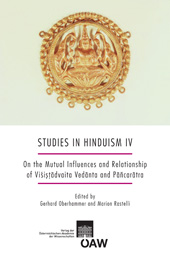


Die religiöse Tradition des Pāńcarātra und die philosophische Schule des Viśiṣṭādvaita-Vedānta haben wesentlich bei der Ausformung der heute in Südindien lebendigen Tradition der Śrīvaiṣṇavas mitgewirkt, sich aber auch gegenseitig in vielen Aspekten beeinflusst. Dieser gegenseitigen Beeinflussung und dem Beitrag der beiden Traditionen zur Entstehung der Śrīvaiṣṇavas widmet sich der vierte Band der Studies in Hinduism. Er enthält folgende Beiträge: G. OBERHAMMER: The Influence of Orthodox Vaiṣṇavism on Viśiṣṭādvaita Vedānta and Pāńcarātra; J.B. CARMAN: Illuminating the Relation Between Pāńcarātra and the Early Śrīvaiṣṇava Community; H. MARLEWICZ: The Question of the Unity of karmakāṇḍa and jńānakāṇḍa According to Rāmānuja; M. SCHMÜCKER: The vyūha as the "State of the Lord" (bhagavadavasthā): Vedāntic Interpretation of Pāńcarātra Doctrines According to Veṅkaṭanātha; P.Y. MUMME: Pāńcarātra Texts in the Tenkalai-Vaṭakalai Dispute; D.D. HUDSON: The vyūhas in Stone; K.K. YOUNG: Brāhmaṇas, Pāńcarātrins, and the Formation of Śrīvaiṣṇavism; S. RAMAN: Initiation and Conversion in Medieval South India: pańcasaṃskāra as Historical Practice in the Śrīvaiṣṇava Post-Rāmānuja Hagiographical Literature; M. RASTELLI: Service as an End in Itself: Viśiṣṭādvaitic Modifications of Pāńcarātra Ritual
Gedruckt mit Unterstützung des Fonds zur Förderung der wissenschaftlichen Forschung (FWF).

…
The religious tradition of Pāńcarātra and the philosophical school of Viśiṣṭādvaita Vedānta have played an essential role in the development of the tradition of the Śrīvaiṣṇavas, which is still present in South India today. However, in addition to this role, they also influenced each other in many respects. This fourth volume in the series Studies in Hinduism is devoted to these mutual influences and the contribution both traditions made to the formation of the Śrīvaiṣṇavas. It includes the following papers: G. OBERHAMMER: The Influence of Orthodox Vai̋ṇavism on Viśiṣṭādvaita Vedānta and Pāńcarātra; J.B. CARMAN: Illuminating the Relation Between Pāńcarātra and the Early Śrīvaiṣṇava Community; H. MARLEWICZ: The Question of the Unity of karmakāṇḍa and jńānakāṇḍa According to Rāmānuja; M. SCHMÜCKER: The vyūha as the "State of the Lord" (bhagavadavasthā): Vedāntic Interpretation of Pāńcarātra Doctrines According to Veṅkaṭanātha; P.Y. MUMME: Pāńcarātra Texts in the Tenkalai-Vaṭakalai Dispute; D.D. HUDSON: The vyūhas in Stone; K.K. YOUNG: Brāhmaṇas, Pāńcarātrins, and the Formation of Śrīvaiṣṇavism; S. RAMAN: Initiation and Conversion in Medieval South India: pańcasaṃskāra as Historical Practice in the Śrīvaiṣṇava Post-Rāmānuja Hagiographical Literature; M. RASTELLI: Service as an End in Itself: Viśiṣṭādvaitic Modifications of Pāńcarātra Ritual
2007,
978-3-7001-3680-4
978-3-7001-3901-0
325 Seiten, zahlr. SW-Abb.,
22,5x15cm, broschiert